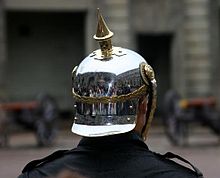From Wikipedia, the free encyclopedia

Prussian police leather Pickelhaube
Contents[hide] |
[edit] History
The Pickelhaube was originally designed in 1842 by King Frederick William IV of Prussia,[2] maybe as a copy of similar helmets that were adopted at the same time by the Russian military.[3] It is not clear whether this was a case of imitation, parallel invention, or if both were based on the earlier Napoleonic cuirassier. The early Russian type (known as "The Helmet of Yaroslav Mudry") was also used by cavalry, which had used the spike as a holder for a horsehair plume in full dress, a practice also followed with some Prussian models (see below). Frederick William IV introduced the Pickelhaube for use by the majority of Prussian infantry on October 23, 1842 by a royal cabinet order.[4] The use of the Pickelhaube spread rapidly to other German principalities. Oldenburg adopted it by 1849, Baden by 1870, and in 1887, the Kingdom of Bavaria was the last German state to adopt the Pickelhaube (they, since the Napoleonic Wars had their own design of helmet called the Raupenhelm). During the second half of the 19th century, the armies of a number of nations besides Russia (including Colombia, Chile, Mexico, Portugal, Norway, and Sweden) adopted the Pickelhaube or something very similar.[5] The Pickelhaube also influenced the design of the British army Home Service helmet, as well as the custodian helmet still worn by police in England and Wales.[6] The basic Pickelhaube was made of hardened (boiled) leather, given a glossy-black finish, and reinforced with metal trim (usually plated with gold or silver for officers) that included a metal spike at the crown. Early versions had a high crown, but the height gradually was reduced and the helmet became more fitted in form. In 1867 an attempt at weight reduction by removing part of the front and rear peaks did not prove successful. Some versions of the Pickelhaube worn by German artillery units employed a ball-shaped finial rather than the pointed spike. Prior to the outbreak of World War I in 1914 detachable black or white plumes were worn with the pickehaube in full dress by German generals, staff officers, dragoon regiments, infantry of the Prussian Guard and a number of line infantry regiments as a special distinction. The Russian version initially had a horsehair plume fitted to the end of the spike, but this was later discarded in some units. The Russian spike was topped with a grenade motif. At the beginning of the Crimean War, such helmets were common amongst infantry and grenadiers, but soon fell out of place in favour of the fatigue cap. After 1862 the spiked helmet ceased to be generally worn by the Russian Army, although it was retained until 1914 by the Cuirassier regiments of the Imperial Guard and the Gendarmerie. The Russians prolonged the history of the pointed military cover with their own cloth Budenovka headgear in the early 20th century. Aside from the spike finial, perhaps the most recognizable feature of the Pickelhaube was the ornamental front plate which denoted the regiment's province or state. The most common plate design consisted of a large, spread-winged eagle, the emblem used by Prussia. Different plate designs were used by Bavaria, Württemberg, Baden, and the other German states. The Russians used the traditional double-headed eagle.
Otto von Bismarck wearing a cuirassier officers' metal Pickelhaube.

The Pickelhaube was often used in propaganda against the Germans as in this World War I poster
[edit] Current use

Ceremonial nickel-plated Pickelhaube of the modern Swedish Royal Life Guard Regiments.
[edit] Cultural icon
In the lead-up to the 2006 FIFA World Cup in Germany, a moulded plastic version of the Pickelhaube was available as a fanware article. The common model was coloured in the black-red-gold of the current German flag, with a variety of other colours also available. The spiked helmet continues to be part of a clichéd mental picture of Imperial Germany, especially in the United Kingdom. This is possibly because of the extensive use of the Pickelhaube in British propaganda during World War I, although the helmet was a well known icon of Imperial Germany even prior to 1914. Pickelhauben were popular targets for British souvenir hunters in the trenches, which prompted German soldiers to leave booby trapped examples behind when retreating.[11] Many motorcycle helmets are modeled after the pickelhaube, giving the rider a "tough guy" image.[edit] See also
| Wikimedia Commons has media related to: Pickelhaube |
[edit] References
- ^ See "The American Pickelhaube" and olimu.com for examples of American military Pickelhaube.
- ^ The German Pickelhaube, 1914-1916, Trenches on the Web web site
- ^ With their helmets being called "The helmet of Yaroslav Mudry, which had a grenade on top, rather than a spike, and was much taller. Introduced in c.1820 and abolished after the Crimean War.Military Fashion by John Mollo (New York: G.P. Putnam's Sons, 1972), page 133 from excerpt cited on What's the origin of the Pickelhaube spiked hat? from the Axis History Forum
- ^ The Model 1842 Pickelhaube from the Kaiser's Bunker web site
- ^ Richard and Henry Knotel, "Uniforms of the World", ISBN0-684-16304-7
- ^ Major R.M. Barnes, page 257 "A History of the Regiments & Uniforms of the British Army, First Sphere Books 1972
- ^ First World War - Willmott, H.P., Dorling Kindersley, 2003, Page 59
- ^ World War One German Army -Stephen Bull, page 71-73
- ^ Charles Woolley, page 368 Uniforms and Equipment of the Imperial German Army 1900-1918,ISBN 0-7643-0935-8
- ^ Andrew Mollo, page 191 Army Uniforms of World War I, ISBN 0-668-04479-9
- ^ "Glossary of Military Terms: "Booby trap"". http://www.army.gov.au/hq3bde/Glossary_of_Military_Terms.asp. Retrieved 2010-12-27.


